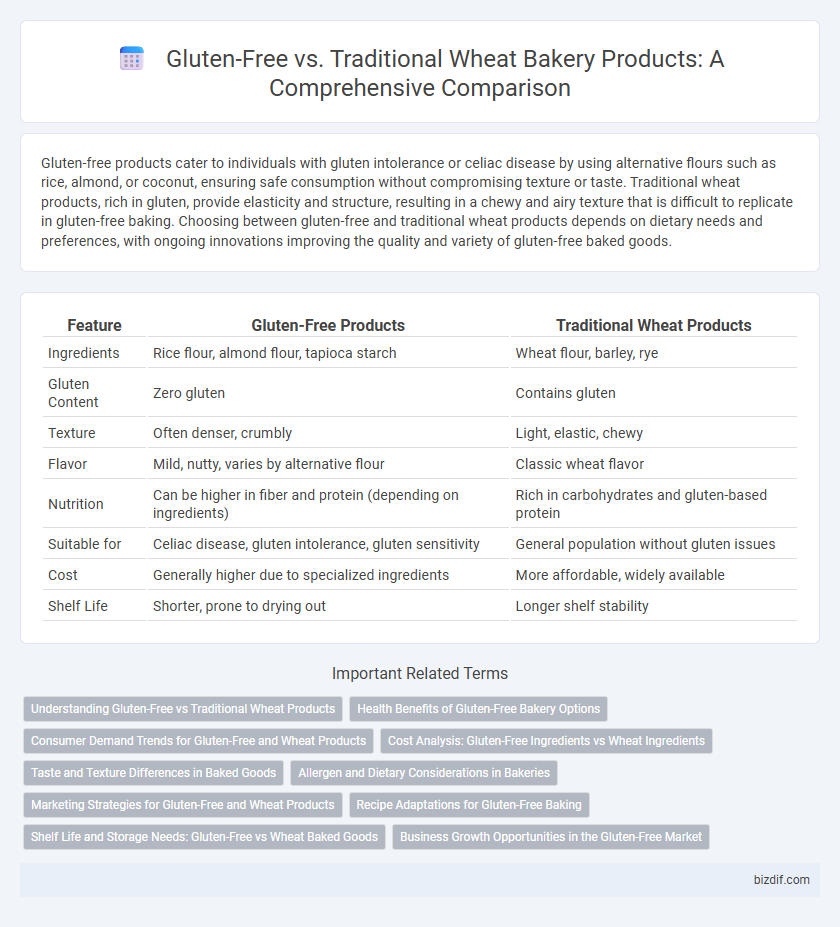Gluten-free products cater to individuals with gluten intolerance or celiac disease by using alternative flours such as rice, almond, or coconut, ensuring safe consumption without compromising texture or taste. Traditional wheat products, rich in gluten, provide elasticity and structure, resulting in a chewy and airy texture that is difficult to replicate in gluten-free baking. Choosing between gluten-free and traditional wheat products depends on dietary needs and preferences, with ongoing innovations improving the quality and variety of gluten-free baked goods.
Table of Comparison
| Feature | Gluten-Free Products | Traditional Wheat Products |
|---|---|---|
| Ingredients | Rice flour, almond flour, tapioca starch | Wheat flour, barley, rye |
| Gluten Content | Zero gluten | Contains gluten |
| Texture | Often denser, crumbly | Light, elastic, chewy |
| Flavor | Mild, nutty, varies by alternative flour | Classic wheat flavor |
| Nutrition | Can be higher in fiber and protein (depending on ingredients) | Rich in carbohydrates and gluten-based protein |
| Suitable for | Celiac disease, gluten intolerance, gluten sensitivity | General population without gluten issues |
| Cost | Generally higher due to specialized ingredients | More affordable, widely available |
| Shelf Life | Shorter, prone to drying out | Longer shelf stability |
Understanding Gluten-Free vs Traditional Wheat Products
Gluten-free bakery products cater to consumers with celiac disease or gluten sensitivity by eliminating wheat, barley, and rye, using alternative flours like rice, almond, or tapioca instead. Traditional wheat products contain gluten proteins that provide elasticity and structure, resulting in the familiar texture and chewiness of breads and pastries. Understanding the differences in ingredients and baking techniques is essential for achieving desirable texture and flavor in gluten-free versus traditional wheat-based bakery items.
Health Benefits of Gluten-Free Bakery Options
Gluten-free bakery options eliminate wheat, barley, and rye, reducing the risk of adverse reactions in individuals with celiac disease or gluten sensitivity. These products promote improved digestion and reduced inflammation compared to traditional wheat-based goods. Incorporating gluten-free alternatives supports better nutrient absorption and overall gut health in sensitive consumers.
Consumer Demand Trends for Gluten-Free and Wheat Products
Consumer demand for gluten-free bakery products has surged significantly, driven by increased awareness of celiac disease, gluten sensitivity, and health-conscious lifestyle choices. Despite this growth, traditional wheat-based products maintain strong market dominance due to their classic taste, texture, and lower cost. The bakery industry is responding by expanding gluten-free offerings while continuing to innovate within traditional wheat product lines to meet diverse consumer preferences.
Cost Analysis: Gluten-Free Ingredients vs Wheat Ingredients
Gluten-free products typically incur higher costs due to specialized ingredients like almond flour, tapioca starch, and xanthan gum, which are more expensive than traditional wheat flour. The supply chain constraints and smaller production scale for gluten-free ingredients further elevate prices compared to mass-produced wheat-based alternatives. Consequently, gluten-free bakery items often have a higher retail price point despite similar production processes.
Taste and Texture Differences in Baked Goods
Gluten-free baked goods often present a denser texture and crumbly consistency compared to traditional wheat products, which benefit from gluten's elasticity and chewiness. Taste differences arise from alternative flours like rice, almond, or tapioca, imparting distinct nutty or earthy flavors absent in wheat-based items. Bakers must balance these variations to achieve desirable mouthfeel and taste, meeting consumer preferences for gluten-free options without sacrificing quality.
Allergen and Dietary Considerations in Bakeries
Gluten-free products in bakeries cater to individuals with celiac disease, gluten intolerance, or wheat allergies, eliminating gluten-containing grains like wheat, barley, and rye to prevent adverse reactions. Traditional wheat products contain gluten, which can trigger symptoms such as digestive distress, skin problems, and respiratory issues in sensitive individuals. Bakeries offering allergen-aware options must prioritize cross-contamination prevention, clear labeling, and ingredient transparency to support diverse dietary needs and ensure customer safety.
Marketing Strategies for Gluten-Free and Wheat Products
Marketing strategies for gluten-free bakery products emphasize highlighting health benefits, targeting niche markets such as consumers with celiac disease or gluten sensitivity, and leveraging certifications like gluten-free labels for trust. Traditional wheat product marketing focuses on taste, texture, and versatility, appealing to a broader audience through nostalgia and ingredient quality. Digital campaigns and influencer partnerships tailored to each segment enhance brand differentiation and consumer engagement in competitive bakery markets.
Recipe Adaptations for Gluten-Free Baking
Gluten-free baking requires precise recipe adaptations, such as substituting wheat flour with alternative flours like rice, almond, or tapioca to replicate texture and structure. Xanthan gum or psyllium husk often replace gluten's elasticity to improve dough elasticity and crumb consistency in gluten-free products. Adjusting hydration levels and baking times is crucial to achieve moisture retention and avoid dryness commonly associated with gluten-free baked goods.
Shelf Life and Storage Needs: Gluten-Free vs Wheat Baked Goods
Gluten-free baked goods typically have a shorter shelf life compared to traditional wheat products due to their lack of gluten, which naturally helps retain moisture and structure. These products often require refrigeration or freezing to maintain freshness and prevent spoilage, while wheat-based items can usually be stored at room temperature for longer periods. Proper packaging and storage conditions are essential for gluten-free products to extend shelf life and ensure food safety.
Business Growth Opportunities in the Gluten-Free Market
The gluten-free market has experienced exponential growth, driven by increasing consumer demand for health-conscious and allergen-friendly bakery products. Bakeries expanding their product lines to include gluten-free options tap into a lucrative niche valued at over $7 billion globally, offering significant revenue potential beyond traditional wheat-based goods. Investing in gluten-free R&D and certification can differentiate brands, attract a broader customer base, and capitalize on rising trends in dietary restrictions and wellness lifestyles.
Gluten-free products vs Traditional wheat products Infographic

 bizdif.com
bizdif.com